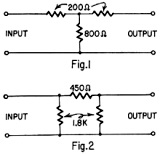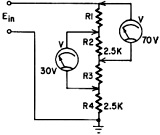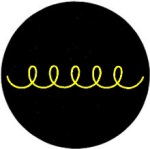|
May 1964 Radio-Electronics
 [Table of Contents] [Table of Contents]
Wax nostalgic about and learn from the history of early electronics.
See articles from Radio-Electronics,
published 1930-1988. All copyrights hereby acknowledged.
|
All three questions in the
May 1964 Radio-Electronics magazine "What's Your EQ?" challenge should
not be too difficult for most RF Cafe visitors. EQ, by the way, stands for "Electronics
Quotient." For the first one, you might want to make use of the Delta-Wye converter
in the newly released (and free)
Espresso Engineering Workbook™. With the Voltage Divider, don't bother
trying to write multiple equations in multiple unknowns. By inspection you can deduce
what the voltage drop across the 2.5 kΩ resistor are, then knowing that
the current through all resistors is the same, figure out the required values of
R1 and R3. Finally, sum all the resistances and multiply by the current. Done. I
have to admit to not getting the Doodle answer. If I had time, I'd do the oscilloscope
thing to verify the author's solution.
What's Your EQ?
 Three puzzlers for the student, theoretician
and practical mono Simple? Double-check your answers before you say you've solved
them. If you have an interesting or unusual puzzle (with an answer) send it to us.
We will pay $10 for each one accepted. We're especially interested in service stinkers
or engineering stumpers on actual electronic equipment. We get so many letters we
can't answer individual ones, but we'll print the more interesting solutions - ones
the original authors never thought of. Three puzzlers for the student, theoretician
and practical mono Simple? Double-check your answers before you say you've solved
them. If you have an interesting or unusual puzzle (with an answer) send it to us.
We will pay $10 for each one accepted. We're especially interested in service stinkers
or engineering stumpers on actual electronic equipment. We get so many letters we
can't answer individual ones, but we'll print the more interesting solutions - ones
the original authors never thought of.
Write EQ Editor, Radio-Electronics, 154 West 14th Street, New York, N. Y. 10011
 Untermination Untermination
Fig. 1 shows an unterminated tee network and Fig. 2 shows an unterminated pi
network. Can you determine the electrical characteristic that the two networks have
in common? - K. Collins
 Voltage Divider Voltage Divider
In the diagram (to the left), R2 and R4 are each 2,500 ohms. Readings taken with
voltmeters (V) assumed to have infinite impedance show 70 volts across R1 plus R2,
and 30 volts across R2 plus R3. What is the input voltage (EIN)? - Harold
J. Turner, Jr.
 Doodles Doodles
How do you produce this waveform on an oscilloscope? - Lee H. Stanton
Answers shown below
Quizzes from vintage electronics magazines such as Popular
Electronics, Electronics-World, QST,
Radio-Electronics, and Radio News
were published over the years - some really simple and others not so simple. Robert P. Balin
created most of the quizzes for Popular Electronics. This is a listing
of all I have posted thus far.
- RF Cafe Quiz #71:
Tech Headlines for Week of 3/13/2023
- RF Cafe Quiz #70:
Analog &
RF Filter Basics
- RF Cafe Quiz #69:
RF
Electronics Basics
- RF Cafe Quiz #68:
RF & Analog Company Mergers & Acquisitions in 2017
- RF Cafe Quiz #67:
RF & Microwave Company Name Change History
- RF Cafe Quiz #66:
Spectrum and Network Measurements
- RF Cafe Quiz #65:
Troubleshooting & Repairing Commercial Electrical Equipment
- RF Cafe Quiz #64:
Space-Time Adaptive Processing for Radar
- RF Cafe Quiz #63:
Envelope Tracking Power Amplifiers
- RF Cafe Quiz #62:
Stimson's Introduction to Airborne Radar
- RF Cafe Quiz #61:
Practical Microwave Circuits
- RF Cafe Quiz #60:
Ten Essential Skills for Electrical Engineers
- RF Cafe Quiz #59:
Microwave Circulator Design
- RF Cafe Quiz #58:
Microwave and Millimeter-Wave Electronic Packaging
- RF Cafe Quiz #57:
Frequency-Agile Antennas for Wireless Communications
- RF Cafe Quiz #56:
Tube Testers
and Electron Tube Equipment
- RF Cafe Quiz #55:
Conquer
Radio Frequency
- RF Cafe Quiz #54:
Microwave Mixer Technology and Applications
- RF Cafe Quiz #53:
Chipless RFID Reader Architecture
- RF Cafe Quiz #52:
RF and Microwave Power Amplifiers
- RF Cafe Quiz #51:
Antennas and Site Engineering for Mobile Radio Networks
- RF Cafe Quiz #50:
Microstrip Lines and Slotlines
- RF Cafe Quiz #49:
High-Frequency Integrated Circuits
- RF Cafe Quiz #48:
Introduction to Infrared and Electro-Optical Systems
- RF Cafe Quiz #47:
LCP for Microwave Packages and Modules
- RF Cafe Quiz #46:
RF, Microwave, and Millimeter-Wave Components
- RF Cafe Quiz #45:
Dielectric and Thermal Properties of Materials at Microwave Frequencies
- RF Cafe Quiz #44:
Monopulse Principles and Techniques
- RF Cafe Quiz #43:
Plasma Antennas
- RF Cafe Quiz #42: The Micro-Doppler
Effect in Radar
- RF Cafe Quiz #41: Introduction
to RF Design Using EM Simulators
- RF Cafe Quiz #40: Introduction
to Antenna Analysis Using EM Simulation
- RF Cafe Quiz #39: Emerging
Wireless Technologies and the Future Mobile Internet
- RF Cafe Quiz #38: Klystrons,
Traveling Wave Tubes, Magnetrons, Crossed-Field Amplifiers, and Gyrotrons
- RF Cafe Quiz #37: Component
Reliability for Electronic Systems
- RF Cafe Quiz #36: Advanced
RF MEMS
- RF Cafe Quiz #35: Frequency
Synthesizers: Concept to Product
- RF Cafe Quiz #34: Multi-Gigabit
Microwave and Millimeter-Wave Wireless Communications
- RF Cafe Quiz #33: Battlespace
Technologies: Network-Enabled Information Dominance
- RF Cafe Quiz #32: Modern Communications
Receiver Design and Technology
- RF Cafe Quiz #31: Quantum
Mechanics of Nanostructures
- RF Cafe Quiz #30: OFDMA System
Analysis and Design
- RF Cafe Quiz #29: Cognitive
Radar
- RF Cafe Quiz #28: Human-Centered
Information Fusion
- RF Cafe Quiz #27: Remarkable
Engineers
- RF Cafe Quiz #26: Substrate
Noise Coupling in Analog/RF Circuits
- RF Cafe Quiz #25: Component
Reliability for Electronic Systems
- RF Cafe Quiz #24: Ultra Low
Power Bioelectronics
- RF Cafe Quiz #23: Digital
Communications Basics
- RF Cafe Quiz #22: Remember
the Basics?
- RF Cafe Quiz #21: Wireless
Standards Knowledge
- RF Cafe Quiz #20: Famous First
Names
- RF Cafe Quiz #19: Basic Circuit
Theory
- RF Cafe Quiz #18: Archaic
Scientific Words & Definitions
- RF Cafe Quiz #17: Inventors &
Their Inventions
- RF Cafe Quiz #16: Antennas
- RF Cafe Quiz #15: Numerical
Constants
- RF Cafe Quiz #14: Oscillators
- RF Cafe Quiz #13: General
Knowledge
- RF Cafe Quiz #12: Electronics
Corporations Headquarters
- RF Cafe Quiz #11: Famous Inventors &
Scientists
- RF Cafe Quiz #10: A Sampling
of RF & Wireless Topics
- RF Cafe Quiz #9: A Smorgasbord
of RF Topics
- RF Cafe Quiz #8: Hallmark Decades
in Electronics
- RF Cafe Quiz #7: Radar Fundamentals
- RF Cafe Quiz #6: Wireless Communications
Fundamentals
- RF Cafe Quiz #5: Company Logo
Recognition
- RF Cafe Quiz #4: General RF
Topics
- RF Cafe Quiz #3: General RF/Microwave
Topics
- RF Cafe Quiz #2: General RF
Topics
- RF Cafe Quiz #1: General RF
Knowledge
- Vacuum Tube Quiz,
February 1961 Popular Electronics
- Kool-Keeping Kwiz, June
1970 Popular Electronics
- Find the Brightest
Bulb Quiz, April 1960 Popular Electronics
-
Where Do the Scientists Belong? - Feb 19, 1949 Saturday Evening Post
|
- What's
Your EQ? - September 1962 Radio-Electronics
-
What's Your EQ? - October 1961 Radio-Electronics
-
What's Your EQ? - November 1961 Radio-Electronics
-
What's Your EQ? - March 1964 Radio-Electronics
-
What's Your EQ? - April 1962 Radio-Electronics
-
What's Your EQ? - May 1962 Radio-Electronics
-
What's Your EQ? - June 1962 Radio-Electronics
-
What's Your EQ? - April 1967 Radio-Electronics
-
What's Your EQ? - March 1967 Radio-Electronics
-
What's Your EQ? - December 1964 Radio-Electronics
-
What's Your EQ? - January 1967 Radio-Electronics
-
Wanted: 50,000 Engineers - January 1953 Popular Mechanics
-
What's Your EQ? - August 1964 Radio-Electronics
- Voltage Quiz
- December 1961 Popular Electronics
-
What is It? - June 1941 Popular Science
- What Do You Know
About Resistors? - April 1974 Popular Electronics
-
What's Your EQ? - September 1963 Radio-Electronics
- Potentiometer Quiz - September
1962 Popular Electronics
-
Mathematical Bafflers - March 1965 Mechanix Illustrated
- Op Amp Quiz -
October 1968 Popular Electronics
- Electronic "A"
Quiz - April 1968 Popular Electronics
-
What's Your EQ? - May 1961 Radio-Electronics
-
Popular Science Question Bee - February 1939 Popular Science
-
What is It? - A Question Bee in Photographs - June 1941 Popular Science
-
What's Your EQ? - June 1961 Radio-Electronics
-
What's Your EQ? - June 1964 Radio-Electronics
-
What's Your EQ? - May 1964 Radio-Electronics
-
What's Your EQ? - August 1963 Radio-Electronics
-
What's Your EQ? - May 1963 Radio-Electronics
- Bridge
Function Quiz - September 1969 Radio-Electronics
-
What's Your EQ? - March 1963 Radio-Electronics
-
What's Your EQ? - February 1967 Radio-Electronics
-
Circuit Quiz - June 1966 Radio-Electronics
-
What's Your EQ? - June 1966 Radio-Electronics
- Electronics
Mathematics Quiz - June 1969 Popular Electronics
- Brightest
Light Quiz - April 1964 Popular Electronics
-
What's Your EQ? - April 1963 Radio-Electronics
- Electronics "B" Quiz
- July 1969 Popular Electronics
- Ohm's Law Quiz
- March 1969 Popular Electronics
-
Antenna Quiz - November 1962 Electronics World
- Color Code Quiz
- November 1967 Popular Electronics
- CapaciQuiz
- August 1961 Popular Electronics
- Transformer
Winding Quiz - December 1964 Popular Electronics
-
Audiophile Quiz - November 1957 Radio-electronics
- Capacitor
Function Quiz - March 1962 Popular Electronics
- Greek Alphabet
Quiz - December 1963 Popular Electronics
- Circuit
Designer's Name Quiz - July 19680 Popular Electronics
-
Sawtooth Sticklers Quiz - November 1960 Radio-Electronics
-
Elementary
Radio Quiz - December 1947 Radio-Craft
- Hi-Fi
Quiz - October 1955 Radio & Television News
- Electronics Physics
Quiz - March 1974 Popular Electronics
- A Baffling Quiz
- January 1968 Popular Electronics
- Electronics IQ
Quiz - May 1967 Popular Electronics
- Plug and Jack
Quiz - December 1967 Popular Electronics
- Electronic
Switching Quiz - October 1967 Popular Electronics
- Electronic
Angle Quiz - September 1967 Popular Electronics
- International
Electronics Quiz - July 1967 Popular Electronics
- FM Radio
Quiz - April 1950 Radio & Television News
- Bridge Circuit
Quiz -December 1966 Popular Electronics
- Diode Function
Quiz - August 1965 Popular Electronics
- Diagram Quiz,
August 1966 Popular Electronics
- Quist Quiz - November
1953 QST
- TV Trouble Quiz,
July 1966 Popular Electronics
- Electronics History Quiz,
December 1965 Popular Electronics
- Scope-Trace Quiz,
March 1965 Popular Electronics
-
Electronic
Circuit Analogy Quiz, April 1973
-
Test Your Knowledge of Semiconductors, August 1972 Popular Electronics
- Ganged Switching
Quiz, April 1972 Popular Electronics
- Lamp Brightness
Quiz, January 1969 Popular Electronics
- Lissajous
Pattern Quiz, September 1963 Popular Electronics
- Electronic
Quizoo, October 1962 Popular Electronics
- Electronic
Photo Album Quiz, March 1963 Popular Electronics
- Electronic
Alphabet Quiz, May 1963 Popular Electronics
- Quiz: Resistive?
Inductive? or Capacitive?, October 1960 Popular Electronics
- Vector-Circuit
Matching Quiz, June 1970 Popular Electronics
- Inductance
Quiz, September 1961 Popular Electronics
- RC Circuit Quiz,
June 1963 Popular Electronics
- Diode Quiz, July
1961 Popular Electronics
- Electronic
Curves Quiz, February 1963 Popular Electronics
- Electronic
Numbers Quiz, December 1962 Popular Electronics
- Energy Conversion
Quiz, April 1963 Popular Electronics
- Coil Function
Quiz, June 1962 Popular Electronics
-
Co-Inventors Quiz - January 1965 Electronics World
-
"-Tron" Teasers Quiz - October 1963 Electronics World
- Polarity Quiz
- March 1968 Popular Electronics
-
Television
I.Q. Quiz - October 1948 Radio & Television News
- Amplifier Quiz
Part I - February 1964 Popular Electronics
- Semiconductor
Quiz - February 1967 Popular Electronics
- Unknown
Frequency Quiz - September 1965 Popular Electronics
- Electronics
Metals Quiz - October 1964 Popular Electronics
- Electronics
Measurement Quiz - August 1967 Popular Electronics
- Meter-Reading
Quiz, June 1966 Popular Electronics
- Electronic
Geometry Quiz, January 1965 Popular Electronics
- Electronic
Factor Quiz, November 1966 Popular Electronics
- Electronics
Math Quiz, November 1965 Popular Electronics
- Series Circuit
Quiz, May 1966 Popular Electronics
- Electrochemistry
Quiz, March 1966 Popular Electronics
- Biz
Quiz: Test Your Sales Ability - April 1947 Radio News
- Electronic
Analogy Quiz, November 1961 Popular Electronics
|
 Untermination Untermination
Each network has a characteristic impedance of 600 ohms. This can be determined
by connecting a 600-ohm load resistor across the output terminals of each and measuring
the effective resistance between the input terminals of each network. Both networks
will have an input resistance of 600 ohms. Since this is the same value as the load
resistance, the characteristic impedance of each network is said to be 600 ohms.
In the tee network, the 600-ohm load resistor is in series with the 200 ohm resistor
on the right-hand side of the network, making the equivalent of 800 ohms. This resistance
is in combination with the 800-ohm shunt resistor, making a series-shunt combination
that equals 400 ohms. By adding the left-hand resistance of 200 ohms to 400 ohms,
the resistance between the input terminals is found to be 600 ohms. Since this is
the same value as the load resistor, the characteristic impedance of the tee network
is 600 ohms.
In the pi network, a 600-ohm load resistor is in parallel with the right-hand
1,800-ohm shunt resistor. This combination equals 450 ohms and is in series with
the 450-ohm network resistor, making a total of 900 ohms. The left-hand shunt resistance
of 1,800 ohms is now in parallel with 900 ohms, which makes the input resistance
across the input terminals 600 ohms. Since the load resistance of 600 ohms equals
the input resistance, the characteristic impedance of the pi network is 600 ohms.
Note:
By using the Wye-Delta or Delta-Wye transformation, it can also be shown that
the two networks are equivalent. The tee and pi networks are examples of Wye and
Delta networks respectively. - Editor
Download the
Espresso Engineering Workbook™ for a Delta-Wye converter.
 Voltage Divider Voltage Divider
This puzzle is not as hard as it seems at first glance. Since the four resistors
are connected in series, the same current must flow through each. We see that R4
has the same resistance as R2. Therefore the drop across R3 plus R4 is the same
as the drop across R2 plus R3 - 30 volts. The total input voltage is 100.
 Doodles Doodles
If the horizontal input of your scope is not disconnected from the horizontal
amplifier when using internal sweep (about 10 or 12 cycles), simply connect the
60-cycle test signal to the vertical input, and also to the horizontal input through
a small capacitor for a 90° phase shift.
If the horizontal input is disconnected when using internal sweep, connect the
capacitor from the 60-cycle test to the horizontal amplifier internally with a clip
lead.
An additional solution for "Doodles" was included in the August 1964 issue:
Doodles in May
The scope trace in the May 1964 issue can also be produced by quickly moving
the HORIZONTAL POSITION knob when the same frequency is put into both horizontal
and vertical inputs, out of phase so as to produce a circular Lissajous figure.
By noting whether the cusps are up or down, you can figure out whether the spot
is moving clock-wise or counterclockwise. Thus you can tell which input,
horizontal or vertical, is leading and which is lagging. I have generated this
pattern for the purpose many times.
- Paul Penfield, Jr.
Posted July 7, 2023
|








 Three puzzlers for the student, theoretician
and practical mono Simple? Double-check your answers before you say you've solved
them. If you have an interesting or unusual puzzle (with an answer) send it to us.
We will pay $10 for each one accepted. We're especially interested in service stinkers
or engineering stumpers on actual electronic equipment. We get so many letters we
can't answer individual ones, but we'll print the more interesting solutions - ones
the original authors never thought of.
Three puzzlers for the student, theoretician
and practical mono Simple? Double-check your answers before you say you've solved
them. If you have an interesting or unusual puzzle (with an answer) send it to us.
We will pay $10 for each one accepted. We're especially interested in service stinkers
or engineering stumpers on actual electronic equipment. We get so many letters we
can't answer individual ones, but we'll print the more interesting solutions - ones
the original authors never thought of. 


